Another Leaf from “Otto Ege Manuscript 214”
(A Dutch Prayerbook)
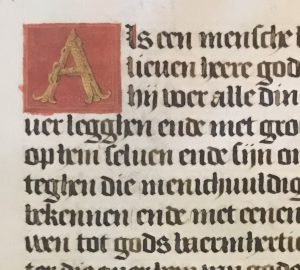
Richard Weber Collection. Single Leaf from “Otto Ege Manuscript 214”? Verso, Top Left. Image reproduced with permission.
Collection of Richard Weber
Single leaf from a small-format Prayerbook in Dutch
Circa 168 × 119 mm <written area circa 129 × 88 mm>
([. . . /]-te sprekene na die sentencie . . .
heest maer puerlijck am die [/ . . .])
Single column of 22 lines in Gothic Bookhand
with embellishments in red pigment
and a painted, framed, decorated initial in ‘rustic’ style
Flanders, circa 1330
Formerly part of ‘Ege Manuscript 214′
(Gwara, Handlist 214)
[Posted on 13 June 2022, with updates]
Another leaf from a medieval devotional manuscript in Dutch dispersed by Otto F. Ege (1888–1951) has come to light. It belongs to the Collection of Richard Weber. Sharing information and images, Richard Weber reports that he purchased it on its own from an online vendor (eBay – oldworldwonders).
Earlier blogposts have begun to report materials from his collection; more are in preparation. For example, so far:
An earlier blogpost considered portions of Ege’s dispersed Dutch manuscript in other collections.
That blogpost focused upon one of the remnants, a single leaf now in a Private Collection. As seen below, the recto stands at the left, with the verso at the right. With the text set out continuously, as paragraphs run together, the script presents seemingly solid blocks of text in successive columns. The initials marking the beginning of phrases or sections are enhanced with vertical strokes of red pigment.
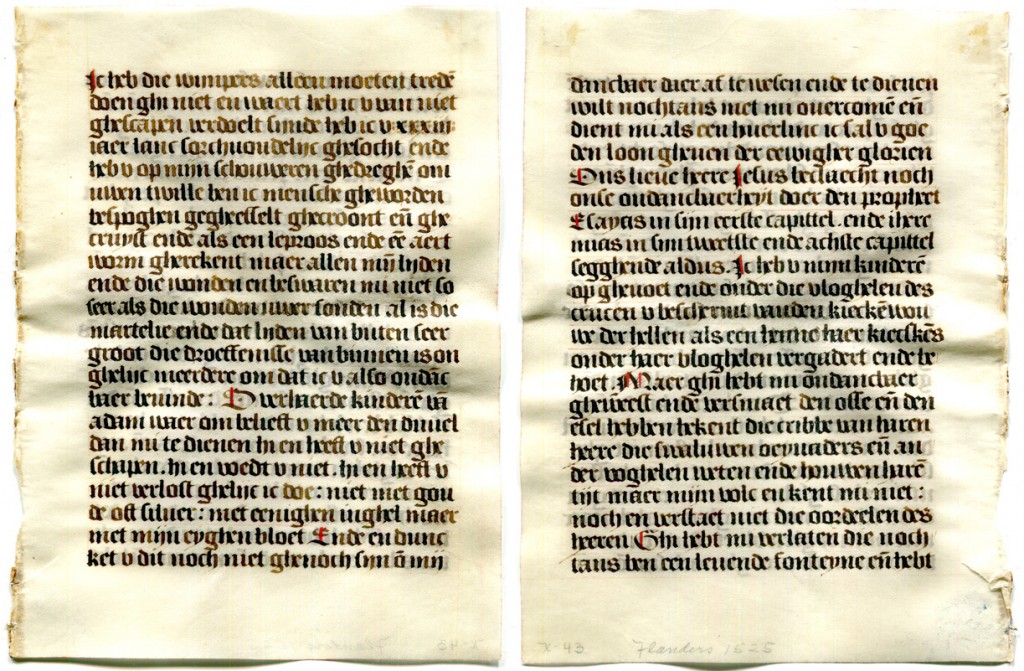 , owned and dismembered by Otto F. Ege” width=”1024″ height=”671″ /> Private Collection. Detached Leaf from ‘Otto Ege Manuscript 214’ (Dutch Prayerbook), Both Sides of the Leaf
, owned and dismembered by Otto F. Ege” width=”1024″ height=”671″ /> Private Collection. Detached Leaf from ‘Otto Ege Manuscript 214’ (Dutch Prayerbook), Both Sides of the Leaf
Some other leaves from the manuscript carry elements of decoration or illustration.
‘Otto Ege Manuscript 214’
In Scott Gwara’s Handlist of Manuscripts Collected or Sold by Otto F. Ege (2013), that manuscript, with some traceable remnants, is his Number 214 (Appendix X, pages 177–178). There he cites a few traceable remnants from it and their appearances in several catalogues. Our blogpost surveyed those resources. See A New Leaf from ‘Otto Ege Manuscript 214?”.
An update to that same blogpost reports other remnants, as identified by Peter Kidd. It quotes his email communication of 15 July 2019 about his discoveries for various Ege manuscripts, including this one. Peter Kidd reported that, for Ege Manuscript 214, that “There are leaves with miniatures at the National Gallery of Art in D.C., the Art Museum in Indianapolis, and (recently acquired) at Oberlin” College, along with the “unilluminated leaf at BU”, that is, at Boston University, School of Theology Library — listed in Scott Gwara’s Handlist. It is:
Some of the identified remnants have some form of illumination. The style is sometimes attributed to the “style of Simon Bening”, that is, Simon Bening (circa 1483 – 1561), one of the most famous and celebrated painters of the 1500s.
A sales catalogue entry for a portion of the manuscript is informative, albeit concise and lacking an illustration.
- Sotheby’s, Western Manuscripts and Miniatures (London, Tuesday 26th November 1985), lot 88. The entry reports:
55 leaves, some detached, others still sewn to old bands with pieces of calf spine, 22 lines, written in dark brown ink by 2 scribes in a late gothic liturgical hand, rubrics in red, capitals touched in red, many initials in red or blue, SIX LARGE ILLUMINATED INITIALS (3- to 4-line) in delicate rustic designs in liquid gold on coloured grounds, fine condition (166mm by 120mm).
Also:
Comprising biblical readings and prayers, including three ascribed to the Commisasrius “meester Godschalc rosemond van Eundhoven, Doctoer in der godeyt” [that is, “Eindhoven in South Holland, about 45 miles south east of Utrecht“], there are offers of indulgences ascribed to popes Alexander VI (1482–1503), Julius III (1503–1513) and Leo X (1513–1521).
The sale included “fifty-four lots of single leaves and miniatures from the collection of Otto Ege”. Various of them comprised the “Residue” of despoiled manuscripts, sometimes with bindings or bits of bindings, left over after the their dismemberment and the distribution of leaves otherwise. It is apparent that the portion from Ege Manuscript 214 was such a case.
The companion Price List of “hammer prices” for the sale indicates that lot 88 was purchased by “Williams” for £330.
The “New” Leaf
The leaf in the Collection of Richard Weber, shown here, has one embellished initial, which occupies a 3-line inset frame. Rubrics in red occur on the other side of the leaf. It is perhaps not too much to ask if this leaf has strayed from the group of fifty-five leaves sold at Sotheby’s.
Recto
This page has a line or more of rubricated text at both top and bottom. The upper rubrication names as authorities “Saint Augustine, Saint Gregory, and other teachers” or Church Fathers.
-te sprekene na die sentencie van Sente
Autustini Sente Gregorius ende ander
doctoren . . .
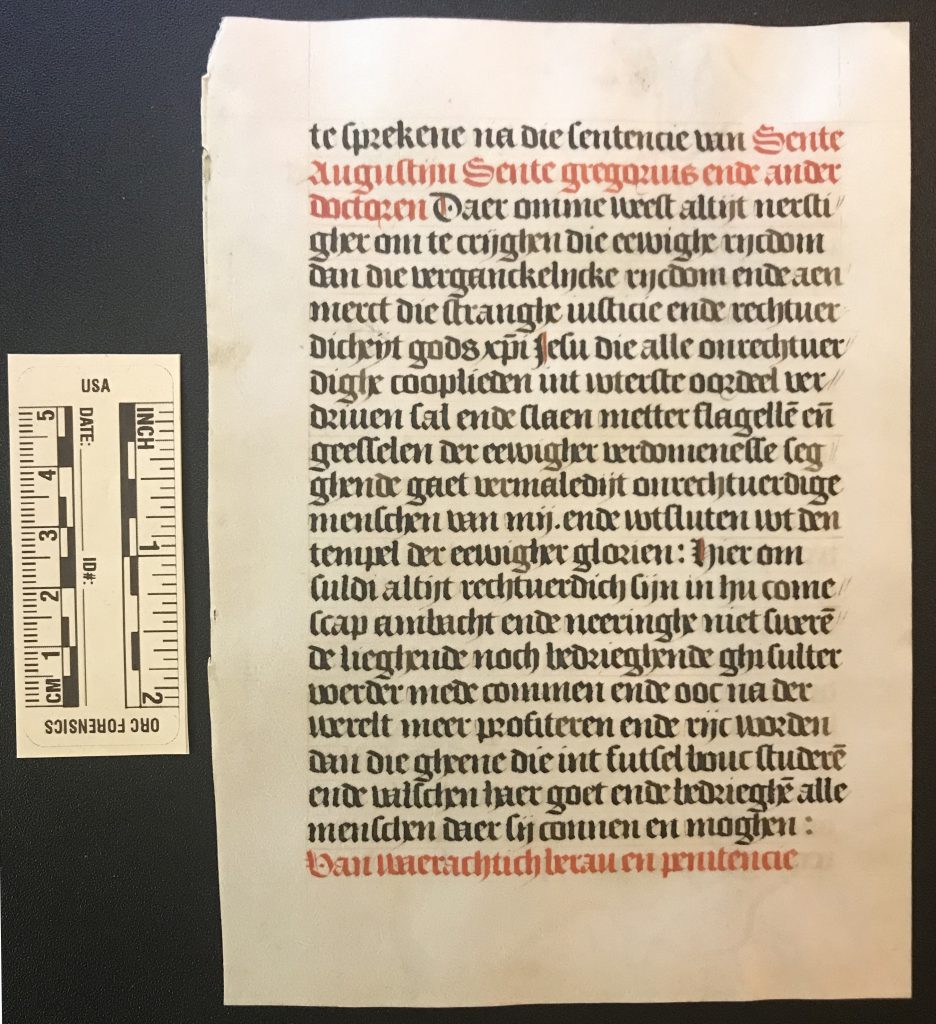
Richard Weber Collection. Single Leaf from “Otto Ege Manuscript 214”
stromectol apotheke
, Verso. Image reproduced with permission.
Verso
This page opens with a decorated initial A, heading a full block-like column of text relieved by two enlarged minor initials (lines 13 and 18) enlivened with a vertical stroke of red pigment.
Als een mensche hem tot onsen / lieuen heere god keere wil so moet . . .
. . . om sijn schade of scande die hii daer mede / vercreghen heest maer puerlijck am die / [. . .]
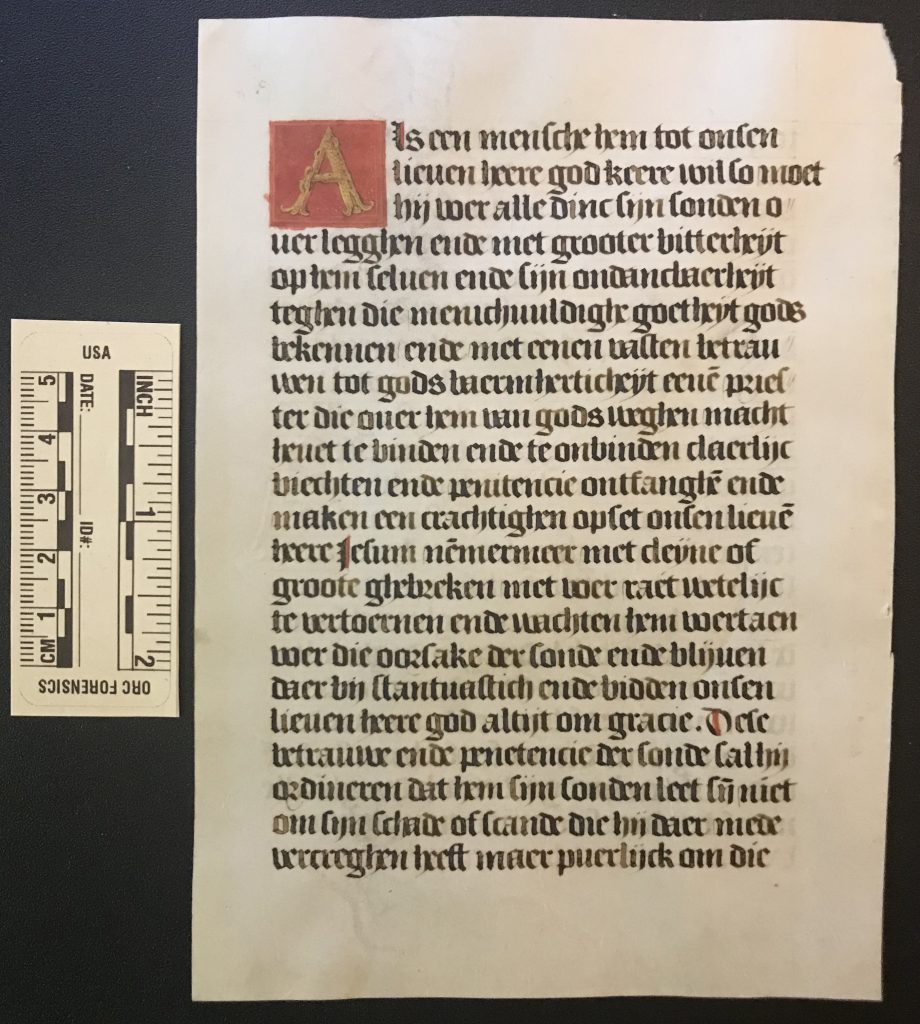
Richard Weber Collection. Single Leaf from “Otto Ege Manuscript 214”? Verso. Image reproduced with permission.
Initial A (of Als)
The inset three-line initial which opens the verso occupies a squared and bordered frame filled with red pigment, which overspreads the outer contour. The background within the initial is likewise filled with red pigment, with the addition of lighter, yellowish, drops or speckles. The red pigment resembles the pigment employed in the rubricated letters and embellishments for minor initials. It may be that the frame for the inset initial was given its red pigment in the same state of operation in preparing the leaf, from script to finishing touches.
The Capital Letter A is rendered in mid-tone brown pigment with dark brown outlines for shading, and with speckles overall in light brown pigment. The letter takes the form of interlocked branch-like or twig-like elements with outspread terminals. The highlights, speckling, and shading enhance the effect of three-dimensional sticks or twigs, hollows, and bark. A fair description of this design, whilst skillfully executed, could be “rustic”.
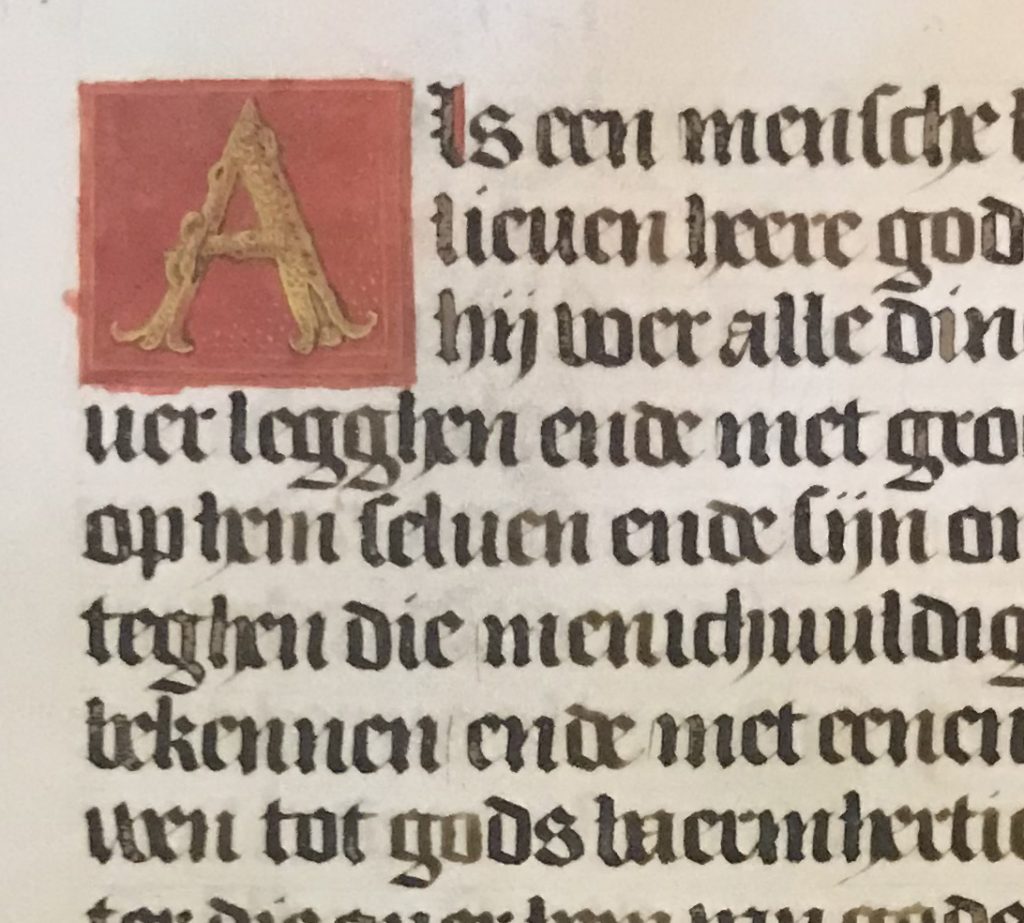
Richard Weber Collection. Single Leaf from “Otto Ege Manuscript 214”? Verso, Top Left. Image reproduced with permission.
*****
We thank Richard Weber for sharing information and images of this leaf, and for answering queries about its features, source, and other aspects.
*****
Do you know of more leaves from this manuscript? Do you recognize the hands of the scribe and scribal artist in other parts of this book or in other manuscripts?
You might reach us via Contact Us or our Facebook Page. Comments here are welcome too. We look forward to hearing from you.
Watch our blog on Manuscript Studies for more discoveries. Please visit its Contents List.
*****
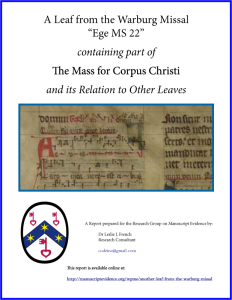


 , owned and dismembered by Otto F. Ege” width=”1024″ height=”671″ /> Private Collection. Detached Leaf from ‘Otto Ege Manuscript 214’ (Dutch Prayerbook), Both Sides of the Leaf
, owned and dismembered by Otto F. Ege” width=”1024″ height=”671″ /> Private Collection. Detached Leaf from ‘Otto Ege Manuscript 214’ (Dutch Prayerbook), Both Sides of the Leaf

